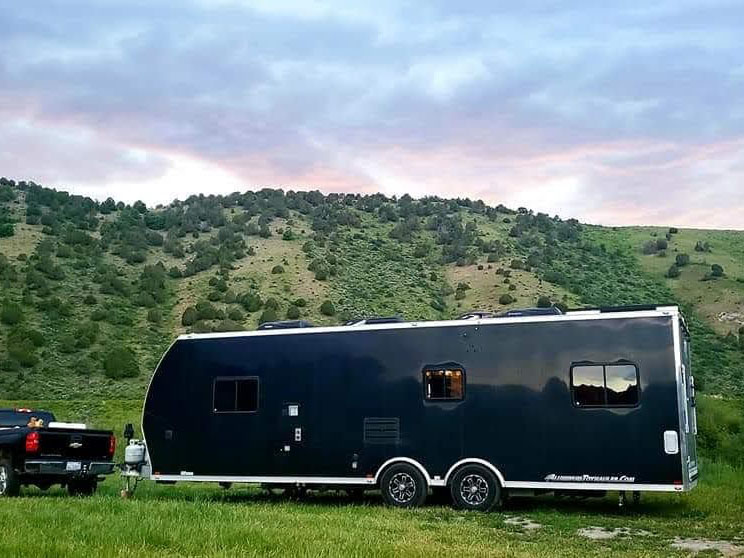Free camping on State Trust Lands is available in many states. State Trust Lands are lands granted by the federal government to states when they entered statehood. Of the 31 states that were granted trust lands, only 16 continue to hold such lands. The other 15 states have since sold off their trust lands.

Camping on State Trust Lands
Not all states permit camping on trust lands. Most don’t even manage their own trust lands.
Idaho, Arizona, and Alaska are perhaps the three most popular states for camping on trust lands. These states have opened up their lands for camping with little to no fees. Idaho permits free camping on most of its trust lands. Arizona and Alaska require you to purchase a permit.
States That Still Hold Trust Lands
Alaska – 1.0 million acres – Camping is permitted on all trust land, but you must purchase a “Land Permit”. Permits are available for up to an entire year at low cost. See, “Camping on Alaska State Trust Lands“.
Arizona – 9.4 million acres – Camping is permitted on most trust lands, but you must purchase a “Recreational Permit”. See, “Camping on Arizona State Trust Lands“.
California – 587,000 acres – All land management is contracted to various cities, counties, port authorities, state and federal agencies. All remaining trust lands are used as part of the State’s commercial waterways, namely marinas, ports, and docks. You’ll have to refer to a specific jurisdiction to determine if camping is permitted.
Colorado – 2.9 million acres – To date, only 850,000 acres of Colorado’s state trust lands are open for “public access”. Public Access lands are leased by other government agencies, or private entities, for recreational uses. Each leasing entity enforces its own rules and policies. See, “Camping on Colorado State Trust Land“.
Idaho – 2.4 million acres, Camping is permitted on most trust lands. There are no fees, no permits required. See, “Camping on Idaho Endowment Lands“.
Montana – 5.1 million acres, Camping is permitted on most trust lands. A “General Recreational License” is required for camping. A 16 day camping limit within a 30 day period is in effect on most trust lands. A 2-day camping limit is in effect on trust lands currently leased to other entities. “See, “Camping on Montana State Trust Lands“.
Nebraska – 1.5 million acres – All state trust lands are used for agricultural leases. No recreational opportunities exist. For more information, refer to, “Nebraska Board of Educational Lands and Funds“.
New Mexico – 9.2 million acres – Recreational camping is generally not allowed. Camping for hunting purposes is allowed with a hunting license but only in specific places set aside for camping. 98% of state trust lands are leased to farmers, ranchers, and other organizations. See, “Camping on New Mexico State Trust Lands“.
North Dakota – 723,000 acres – Camping is not permitted on State Trust Lands. The only recreation permitted is hiking, bird watching, fishing and hunting. For more information, refer to, “North Dakota Department of Trust Lands, Public Access Information“.
Oklahoma – 785,000 acres – Camping and other forms of recreation is permitted only to those who have leased land from the Commissioners of the Land Office. You are not allowed to enter trust lands that you have not leased, unless you have permission from the lessee. For more information, refer to, “Commissioners of the Land Office“.
Oregon – 780,000 acres – Camping is allowed on all State Trust Lands without fees or permits, as long as the land is publicly accessible. Most of the lands are located in the south east quadrant of the state, but there is some sizeable lands in the Coos Bay area too. See, “Camping on Oregon State Trust Lands“.
South Dakota – 750,000 acres – Day-use recreation such as hunting and fishing is permitted on State Trust Lands, but overnight camping is generally frowned upon. Almost all of South Dakota’s State Trust Lands has been leased out. Many lessees have already established roads leading into their trust lands, and prior notification is generally not required. See, “South Dakota School & Public Lands“
Texas – 1,700,000 acres – Camping is not permitted on State trust lands. Very few, if any, recreational opportunities exist. The State of Texas has set up a network of trustee organizations, each of whom manage portions of state trust lands. All of these lands are held for conservation purposes. See, “Texas Land Trust Council” for more information.
Utah – 3.7 million acres – Camping is allowed on all State Trust Lands without fees or permits, as long as you camp in the same place for no more than 15 days. Hunting, fishing, OHV riding, hiking, and other forms of recreation is permitted. For more information, see, “Camping on Utah State Trust Lands“.
Washington – 3.3 million acres – Camping is permitted on specific State Trust Lands designated as recreation areas. Some recreation areas permit dispersed camping, while others are limited to designated campgrounds. For more information, see, “Camping on Washington State Trust Lands“.
Wyoming – 3.6 million acres – Camping is not permitted anywhere on State Trust Lands. Only day-use recreation is permitted, including hunting, fishing, trapping, hiking, etc. Off-road vehicle use is not permitted. For more information, see, “Office of State Lands and Investments“.
What are State Trust Lands?
State Trust Lands are lands that Congress granted to a state at the time it entered statehood.
Before a state entered the union, it was a territory that existed mostly on federally-owned lands, and some privately owned lands. Once it entered statehood, Congress transferred millions of acres of land to that State for purposes of raising revenue. That state was expected to either sell off that land for quick cash, or find ways to create recurring revenue in the form of leases or use fees. Those revenues would be used to pay for publicly-owned institutions such as schools, hospitals, and prisons.
Idaho creates most of its state trust land revenues in the form timber fees. Arizona creates most its state trust land revenues from agricultural leases. California creates most of its state trust land revenues from port authority operations.
Of the 31 states that were granted state trust lands, only 16 continue to hold such lands.

